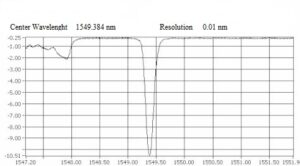 Specialized sensors known as Tilted Fiber Bragg Gratings (TFBGs) expand the capabilities of Fiber Bragg Grating (FBG) technology. In a range of applications TFBGs display unique optical properties and improved performance due to their capability to activate cladding modes through using tilted grating planes in regard to the fiber axis. In addition to maintaining all the well-established benefits of FBGs, this structural innovation makes TFBGs valuable in fiber-optic technology by allowing single-point sensing in challenging areas.
Specialized sensors known as Tilted Fiber Bragg Gratings (TFBGs) expand the capabilities of Fiber Bragg Grating (FBG) technology. In a range of applications TFBGs display unique optical properties and improved performance due to their capability to activate cladding modes through using tilted grating planes in regard to the fiber axis. In addition to maintaining all the well-established benefits of FBGs, this structural innovation makes TFBGs valuable in fiber-optic technology by allowing single-point sensing in challenging areas.
How Tilted Fiber Bragg Gratings (TFBGs) work
A short-period optical fiber grating is known as tilted fiber Bragg grating (TFBG), sometimes it’s referred to as a blazed or slanted grating. The same methods applied to create Fiber Bragg Gratings (FBGs) are also employed to manufacture TFBGs, featuring an interference pattern formed by ultraviolet laser beams to alter the refractive index of doped glass.
Unlike ordinary FBGs, TFBGs include grating planes tilted at a specified angle relating to the fiber axis. Not only does this tilt angle improve coupling between guided modes and either counterpropagating or copropagating modes at specific wavelengths, but it also affects the grating period which influences mode coupling. As a result, TFBGs provide complex interactions between core, cladding, and radiation modes, resulting in a transmission spectrum with many resonance peaks, making them ideal for sophisticated sensing applications.
Mode coupling and sensitivity enhancement
Enhancing sensing capabilities requires Tilted Fiber Bragg Gratings (TFBGs) to transfer light from guided core modes into radiation or cladding modes. In order to perceive this process, the core mode is investigated by a more straightforward two-layer model, while cladding modes are studied by a theoretical model that considers the fiber as a three-layer structure. The sensor susceptibility to fluctuations in the refractive index of the surrounding medium is improved by decreasing the cladding radius since it enhances the energy transfer from the cladding modes to the core.
Furthermore, a variety of TFBG sensors suited to a broad range of applications can be designed due to the high sensitivity of their coupling efficiency to light polarization.
Tilted Fiber Bragg Gratings (TFBGs) advantages
- Multi-functionality: TFBGs are adaptable instruments for sensing applications since they can combine several light modes to react to multiple measurements.
- High sensitivity: TFBGs can obtain great sensitivity, especially for measuring temperature and strain because of their efficient use of mode coupling effects.
- Diverse applications: Their efficacy and versatility are demonstrated by their usage in a variety of domains, including optical communications, structural health monitoring, medical diagnostics, and environmental sensing.
TFBGs applications
TFBG sensors are used for monitoring and measuring mechanical changes as well as in biological areas. They include one-dimensional TFBG devices like vibroscopes, accelerometers, and micro-displacement sensors, as well as two-dimensional TFBG instruments like vector vibroscopes and rotation sensors. Reflective TFBG refractometers are available in-fiber and fiber-to-fiber configurations, whereas polarimetric and plasmonic TFBG biochemical sensors can detect cells, proteins, and glucose levels in situ.
Being an important step forward in optical fiber technology, tilted fiber Bragg gratings (TFBGs) combine distinctive structural characteristics with a wide range of beneficial applications. They are vital in current technological advancements owing to their mode coupling qualities and high sensitivity.

